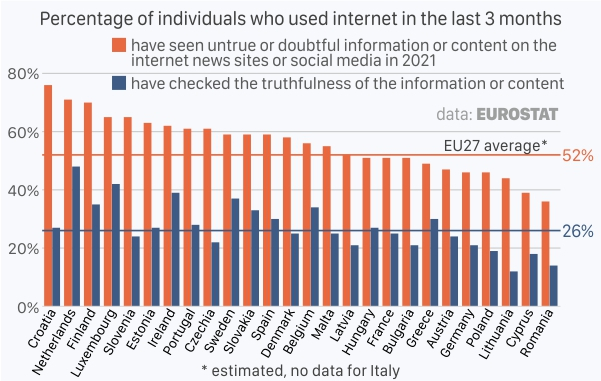 Credit: Kangkan Halder
Credit: Kangkan Halder
In 2021, 52% of all people aged 16 to 74 years old living in the European Union (EU) who used internet in three months prior to survey saw untrue or doubtful information on news websites or social media.
However, only half of them (26%) verified the truthfulness of the information or content.
The survey, from which these results have been drawn, was conducted by the European statistics agency Eurostat as part of the Information and Communication Technologies (ICT) usage in households and by individuals in the EU.
Data for Italy is not available and hence the EU average is estimated.
The share of people aged 16 to 74 years old who used and saw untrue or doubtful information on news websites or social media in the previous three months was largest in Croatia (76%), the Netherland (71%) and Finland (70%). The smallest share was noted in Romania (36%), Cyprus (39%) and Lithuania (44%).
65% of Luxembourg residents aged 16 to 74 years who used internet in the previous three months and saw untrue or doubtful information, ranked fourth highest in the EU.
Importantly, the share of people who verified doubtful information by checking sources or finding additional information and following or taking part in online or offline discussions, was largest in the Netherlands (48%), followed by Luxembourg (42%) and Ireland (39%). The smallest share or least interest in verifying doubtful information was recorded in Lithuania (12%), followed by Romania (14%) and Cyprus (18%).
Across the EU, on average 17% of people did not checked the truthfulness of the information because they already knew that the information, content or source was unreliable.
About 5% of people expressed a lack of skills or knowledge to verify doubtful information or content online.
In Luxembourg, 87% of 20 to 24 year-old men reported having seen untrue or doubtful information compared to 66% in women in same age group. In contrast, smaller share of older people of age 55 to 74 years old saw doubtful information or content, at 53% for males and 41% for females.
Non-EU Luxembourg residents reported seeing more doubtful content (72%) compared to nationals (63%) and rest-of-EU residents (65%).
In terms of household composition, 69% of individuals with children witnessed untruthful or doubtful information compared to 62% of individuals living without children.








